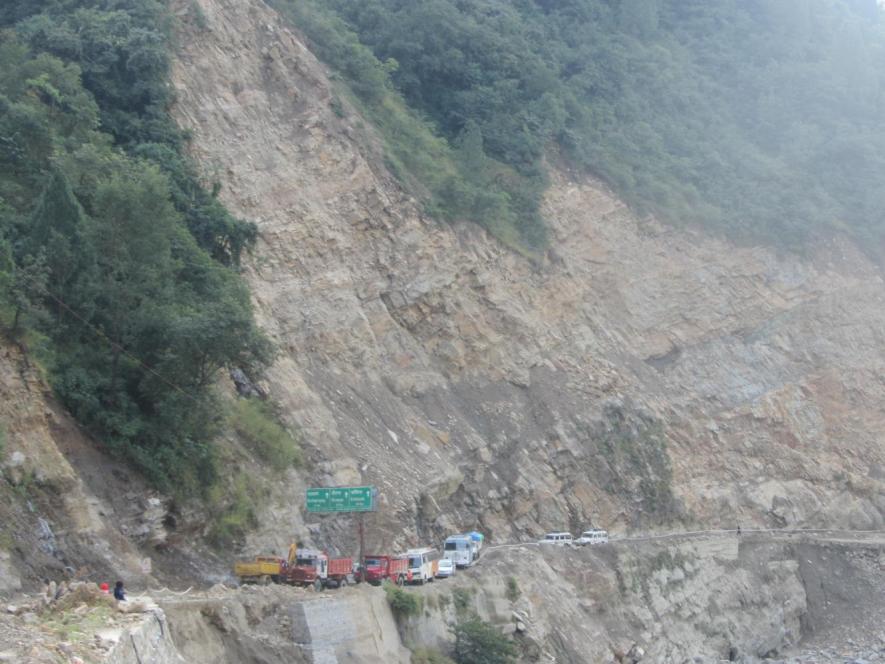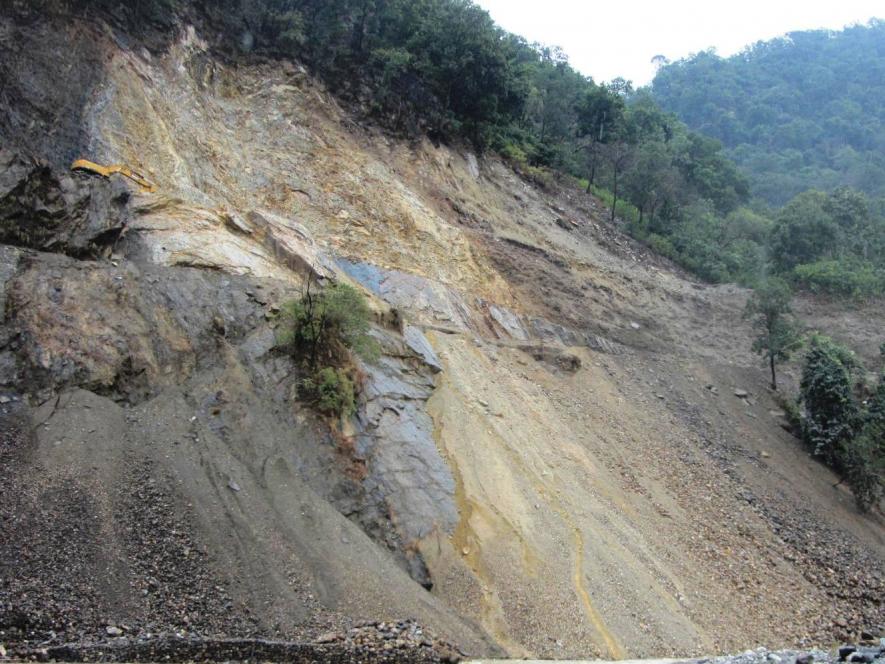Char Dham Project: Environmentalists Hail SC Directive on Road Widening

Image Courtesy : Hemant Dhyani.
In a befitting tribute to the mighty Himalayas on Himalayan Day, (September 9) the Supreme Court directed the Centre on Tuesday to abide by the circular of the Ministry of Road, Transport and Highways (MoRTH) issued in 2018 with regard to the construction of an all-weather road network to connect the four holy shrines in Uttarakhand. The circular had stipulated a carriageway of 5.5 metre-width with two-lane structures.
The Char Dham project, worth about Rs 12,000 crore, is one of the largest road-widening project in the Himalayan region. It was inaugurated by Prime Minister Narendra Modi in December 2016.
An affidavit by MoRTH was submitted by Solicitor General Tushar Mehta in the court, which advocated for a seven-metre wide road. It cited the need for wider roads for easy movement of army vehicles on the road to international borders, such as the Indo-China border.
The Centre also said that 13 out of a total 53 projects the under Char Dham Project (CDP) – work on which is yet to commence – also includes seven strategic roads like NH-58, NH-108 and NH-125. The 53 projects cover 163 kms out of a total 889 kms under the CDP.

Image Courtesy : Hemant Dhyani.
Mehta told the court that 21 members of the court-appointed High Powered Committee (HPC) voted in favour of a ten-metre carriageway and only five opted for the 5.5-metre specification.
A bench of Justices R.F. Nariman, Navin Sinha and Indira Banerjee rejected the Centre’s arguments, and decreed in favour of 2018 circular.
The 2018 circular says that “challenges have come to the fore in adhering to these standards (10m carriageway as per circular issued in 2012) in the context of National Highways and roads in hilly and mountainous terrains. These challenges arise on account of destabilization of hill slopes and progressive damaging effects on road alignments and structures in higher contours on hills due to excavation works, requirement for large-scale felling of precious trees, associated environmental damages. Resultantly, there arises need to provide largescale protection works, acquisition of additional land for Right of Way (ROW), etc. Therefore the carriageway width shall be of intermediate lane configurations, i.e. of 5.5 m width (18 ft), with two-lane structures (23 ft.).”
Sanjay Parikh, the petitioners’ advocate said: “The 2012 circular has been applied by MoRTH under the CDP, as a result of which illegal hill cutting has been done leading to severe devastation. The ministry should now undertake plantation work on the excess area outside the configuration of intermediate road, where work has been completed.”
Aggrieved by recurring landslides and road blockages caused due to the sheer negligence exhibited by the contractors by way of alleged steep-hill cutting, mindless tree felling, untreated slopes and indiscriminate muck dumping, some activists moved the apex court which then formed the HPC in August last year to monitor the project.
The members of HPC, however, were divided on the issue of road width. The majority opted for a 10 metre-wide tarred road. However, its chairman, noted environmentalist Ravi Chopra, and four others favoured a 5.5-metre tarred road. They emphasised that a ten-metre tarred road requires widening up to 12 metres and mountain cutting to 24 metres, leading to more damage to the forest and the environment.
It was only after the voting was done that the MoRTH circular from 2018 came to the knowledge of the chairman and other members. Chopra asked the majority to change their opinion in view of this circular. However, they refrained. Chopra then put the matter to the SC, which gave its verdict on Tuesday.
The conservationists have welcomed the SC verdict.
Mallika Bhanot, prominent member of the Ganga Ahwan movement, told NewsClick that the top court had delivered a judgement “in favour of the Himalayan ecology which is already fragile. The missing part is that the court should have also fixed the accountability of all the illegal work and violations that have been committed by the project proponent and MoRTH and punished the guilty.”
Noted environmentalist and Padma Bhushan awardee, Chandi Prasad Bhatt, also welcomed the court’s verdict, saying that he had brought the “fragile” nature of the Uttarkashi area to the notice of union transport minister Nitin Gadkari, “particularly the stretch from Bhaironghati to Gangotri which is home to precious deodar trees. I hope that the massive damage which has already been done to the environment under CDP will not be repeated in the remaining stretches. I appeal that proper slope treatment, muck dumping and plantation work should happen alongside the road widening work.”
Hemant Dhyani, environmental activist and a member of the HPC, told NewsClick that the committee will monitor the project. He added that in the light of the apex court’s order, in the roads which have been widened to 10m instead of 5.5m under the project, it will be ensured that the surplus area is devoted for space for pavement for pilgrims, drainage and plantation work, as per the mandate given to the HPC.
Anil Joshi, a Padma Shri awardee and environmentalist applauded the court for backing scientific logic than the majority’s opinion. “We must use scientific techniques to build the roads and related work such as slope treatment while taking up as much time as required, instead of rushing to meet targets without bothering for environmental concerns,” he said.
Shekhar Pathak, founder of People's Association for Himalaya Area Research, also a Padma Shri awardee, expressed his dismay with the Centre, saying that the MoRTH kept the committee in the dark by not sharing the 2018 circular. Had it been known earlier, there was no need for voting which created a rift among the members, he said. “The Centre is unnecessarily wasting Rs 12,000 crore on this project. It would have been better if the same money was used to better the existing roads of the state,” he added.
Y.P. Sundriyal, an academician and geologist, was of a similar opinion. “Recently, three JCB operators working on the CDP died at Vyasi near Rishikesh when boulders from an untreated slope crushed them. So many lives have been claimed due to landslides triggered by this project. Such cases are prolific on national highways, where some kind of work is usually ongoing in the state. But in case of old branch roads where human intervention is minimal, such problems are not there,” he explained.
The writer is a freelance journalist who writes on environment.
Get the latest reports & analysis with people's perspective on Protests, movements & deep analytical videos, discussions of the current affairs in your Telegram app. Subscribe to NewsClick's Telegram channel & get Real-Time updates on stories, as they get published on our website.
























